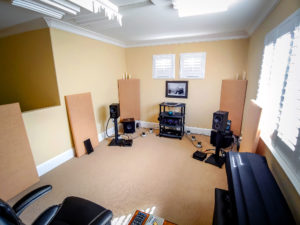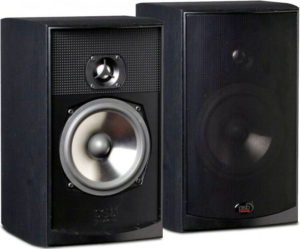Publisher’s note: Announcing a new Series, “Reign of the Mini-Monitors.”
Loudspeaker systems pressurize the space between the speakers themselves and the listener. Placing large, multi-driver speakers in a small room curtails the system’s potential, while forcing a pair of small speakers to play in a large room exposes their limitations. Using the right size of speakers in any given room, however, can bring about a very realistic recreation of the recording venue, be it an intimate jazz club, a 100-piece-plus symphony hall or a cathedral.
Dagogo Reviewer David Snyder uses the top floor room in his house as his dedicated listening room. Its dimensions are 15.5 feet long, 10.1 feet wide and 8′ high. This new Series will share his continuing discoveries on mini-monitors with our readers.
About loudspeaker design/designers
The saying goes that designing great-sounding loudspeakers is more art than science. I’ve had the opportunity to discuss the matter with a number of loudspeaker designers, and each seems to have their own approach and priorities. You see, the problem is that there are an impossible number of variables to consider—hundreds, if not thousands, of different driver and enclosure materials and types, even more ways to combine and assemble them, and countless ways they can interact with listeners’ rooms. A good designer will prioritize the manageable subset of parameters that they feel are essential to achieving their goals.
When you study the designs of popular manufacturers, patterns begin to emerge. Some espouse matching piston area to the frequencies being reproduced, while others are more concerned about moving mass. Ultra-wide dispersion is a common characteristic of some designs while other designers are all about controlled directivity. Some build different models around the single high-frequency transducer that they poured most of their R&D into while others focus on getting the midrange right.
There are at least as many sets of design priorities as there are designers. After exposure to many different loudspeakers, one begins to develop her/his own preferences and priorities. Since you can’t try all of them, I suggest that you pay attention to the designers of products that interest you and follow those whose priorities are aligned with your own, keeping in mind that these may change over time.
As a personal example, for most of my audiophile life, I was into piston area; borrowing a line from muscle car enthusiasts: there’s no replacement for displacement! I enjoy the big ease with which big loudspeakers make big sound. However, after a move to the west coast, I found myself and my system in a much smaller room. This change forced me to consider the interaction between speakers and room on a much deeper level than I had in the past. Standing waves, dispersion, power response and driver integration are bigger problems with big speakers in a small room. Bass traps and room treatments combined with judicious use of DSP got me close to the sound that I wanted, but I ultimately discovered that you just can’t fight the room!
Enter Paul Barton, the “P” and “B” in PSB Speakers (“S” is for Sue, his beloved wife). He’s been designing loudspeakers since before I could walk, and while studying under Dr. Floyd Toole at the NRC (National Research Council) in Canada, he discovered that the power response of a loudspeaker is at least as important as its response on-axis. Paul would explain that most of us don’t listen to loudspeakers in an anechoic chamber or in free space; our listening rooms have a floor, ceiling, and walls with all sorts of reflective surfaces. Rooms collect and store acoustic energy from the entire sphere around the transducers. The sound that arrives at our ears is actually a mix of direct sound, reflections from nearby surfaces, and tonality of the diffuse field, which consists of secondary reflections and beyond. A design with flat on-axis response but lumpy or uneven response off-axis may measure well in the lab, but the relationships among fundamentals and harmonics will be distorted in any real listening room, resulting in a tonality that fails to match real-life acoustic instruments like the violin.
Paul Barton’s primary design priority is to achieve perceptually flat response on-axis while also delivering smooth response from all angles in the sphere surrounding the loudspeaker. He’s been utilizing the loudspeaker testing facilities at the NRC to achieve this design goal for longer than anyone on the planet and has become incredibly good at it. Every aspect of his speaker designs, from driver construction and materials to waveguides, baffles and enclosure shapes and materials, and crossover characteristics supports this goal across his entire line of products.
About the PSB Alpha
When the original PSB Alpha loudspeaker was launched in 1991, Paul wanted to create an affordable speaker that heavily prioritized sound quality over features. There were no 5-way binding posts or removable grills. The woofer was flush-mounted from the rear of the baffle, and the crossover was simple. This left more of the budget for quality components and design, and the results spoke for themselves. The PSB Alpha was the budget darling of the audiophile press for more than a decade after it arrived on the scene, establishing it as a sonic benchmark for what could be achieved under $200 USD. An updated Alpha B1 model followed in 1999 and was in continuous production for nearly 20 years!
For 2019, Paul decided to apply that same design ethos to the creation of a new Alpha line that could meet a range of needs from quality 2-channel performance to fine home theater. He designed new drivers, waveguides, enclosures and crossovers from the ground up using modern materials and lessons learned while creating his high-end Imagine series. The results are in line with what you’d expect from a music-first designer with nearly a half-century of study and experience.
- (Page 1 of 4)
- Next page →




Thank you for a fine, interesting and fairly comprehensive review.
Many points of interest arose in viewing your setup. The room and equipment treatments are of particular interest.
I see you follow REL’s recommendation for corner placement of the subs. It’s gratifying to see you confirm that methodology. And, that you’re obviously a fan of the iFi AC purifiers.
What brand of bass traps are those? If I might be so bold, have you tried placing the subs on inexpensive granite tile slabs, which in turn rest on carpet spikes? Reportedly that will provide a tightening of bass.
Perhaps in future article(s) you could offer a few words in connection with ancillary accessories that you have found of value that do not require a dedicated music room?
I for one am looking forward to future articles on mini-Monitors, as I’m strongly considering the Dynaudio Emit M10 speakers. My Rega Brio (2017) Integrated Amp just died on me and in response I’m upgrading my amplification, which in turn is prompting me to upgrade from my Wharfedale 80th Anniversary ‘Denton’ speakers. (fine midrange, good bass but a bit ‘reticent’ in the treble… a bit too ‘relaxed’ is my assessment).
Hi Geoffrey,
Thanks for your kind words and for expressing an interest in the system context for this review. As you have observed, I have taken a rather pragmatic approach to system assembly and room tuning vs. “cost is no object.” I do appreciate REL’s ethos regarding not only placement but also electrical connection–feeding them signal from the same amplification channels that drive the main speakers. Both seem to support integration uniquely and effectively.
The bass traps and panels are from ATS Acoustics. Without them, the room has an RT60 of over 600 ms (pretty terrible). With treatment from ATS, RT60 is under 300 ms at the listening position. The QRD diffusers on the ceiling are from GIK Acoustics.
I have not tried spiked platforms under the subs; however, I have the crossovers set quite low. The presence of the T7i’s in the system is primarily to add a pinch of sub-bass pressurization rather than to augment bass output from the main speakers. I suspect that a platform and spikes might be more relevant if I were to cross them over higher. Thanks for the suggestion since it could be relevant when evaluating less capable monitors with these subs. Note: The RELs were powered off for most of my listening with the PSB Alpha P5!
Within more “lifestyle” listening spaces, the challenge is getting the environment quite enough to appreciate the subtle improvements to dynamics and resolution that most audio accessories are intended to deliver. The “Acoustic Art Panels” and “Acoustic Coffee Bag Panels” from ATS Acoustics may be an effective way to reduce the blurring effect of reflections while not spoiling décor. ATS also offers free online room acoustics analysis which can be helpful to estimate how many panels are required to effectively treat even a shared living space.
You make a good point that we pair loudspeakers to the room and amplification to the loudspeakers. The Denton 80’s should serve you very well and certainly look great. Enjoy!
— David